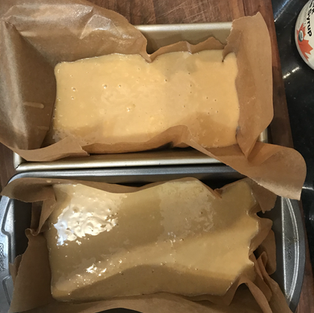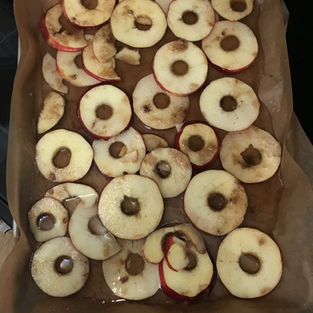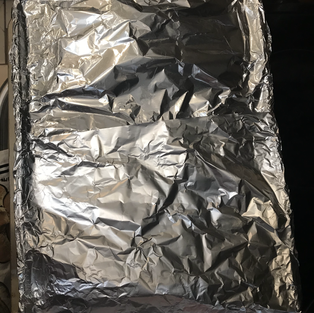The History of Honey Cake ft. Michael Solomonov's Honey Cake with Apple Confit!
- Rachel Westerfield

- Sep 19, 2020
- 4 min read
Where Did Honey Cake Come From?
Rosh Hashanah is the Jewish New year and sweet things are eaten to symbolize the hope of a sweet year to come.
The earliest documentation of “honey cake” is in the early 12th century in Egypt and Rome. Sugar was not available and the method of grinding wheat and rye into flour had just been invented. This led to Egyptians and Romans mashing up wheat and barley and mixing it with honey. The Roman cakes were called placenta and were made of cheese as well. These cakes were offered as sacrifices to the gods. Legend has it that the baker forgot about the cake and it sat out for a month, during which it rose and formed a “cake.” The “honey cake” was very similar to a panforte, a chewy, flat, dense Italian that is filled with nuts, fruits, and spices. In Slovakia, it became a tradition for daughters of honey makers to receive big barrels of honey cake dough at their weddings. The dough could be good for 30 years. In Prague, it is called Medovnik and is made with three pastry layers bound by custard. Leftover flour is used to cover the outside of the cake. Honey cake has also become a staple dessert in the Czech Republic.
Around the same time, 1105, Ashkenazi Jews took in gingerbread, a variation on the original honey cake. Their gingerbread was described as a fine floured challah with honey which was later officially named lekach, which means lick in German. Ashkenazi Jews celebrated the accomplishment of learning the Torah for the first time by offering the student a slate of honey that had Hebrew letters to lick as well as a honey cake. The sweetness was to celebrate the study of the Torah. During the 19th century in England and the US, “old fashioned honey cake” was sometimes served at tea time.
As honey cake started to disappear with the introduction of sugar in the 1500s, people forgot about the silky, smooth texture of honey. As communism fell in the Czech Republic and Slovakia, honey cakes came back to honor tradition.
Honey cake is like banana bread in the way that it is moist and as it “ages” it gets better. A honey cake can last for weeks because honey is a natural preservative! Michael Solomonov writes in his recipe that his mother freezes one and sends it to him from Israel to his home Pittsburgh! Sometimes round honey cake is brought out on Rosh Hashanah to symbolize the circularity of the Jewish New year (similar to round challah).
Honey cake is kind of seen as the fruit cake of Judaism in the sense that some people love it, others not so much. Honey cake and fruit cake come from the 1800s- early 1900s in which dessert was dense and heavily spiced. Honey cake is sometimes seen as an idea of tradition rather than an enjoyable dessert. Many modern takes have lightened the spices and aren’t as dense.

Pictured above is my attempt at Michael Solomonov's, "My Mother's Honey Cake with Apple Confit."
Here is a recipe from https://www.thedailymeal.com/recipes/my-mother-s-honey-cake-apple-confit-recipe The recipe can also be found inside his cookbook Zahav.
Ingredients: For the Cake:
2 1/2 cups flour
2 teaspoons baking soda
3 eggs, beaten
1 cup sugar
2/3 cups honey
1 1/4 cup brewed coffee
6 tablespoons canola oil
Salt
Pinch cinnamon
For the Apple Confit:
3 apples, peeled and sliced thinly crosswise
1 cup sugar
1 vanilla bean, split
2 cinnamon sticks
1 tablespoon honey
3 cloves
Directions: For the Cake: Preheat the oven to 350 degrees F. Line 2 loaf pans with oiled parchment paper.
Combine the flour and baking soda in a mixing bowl and whisk well. Set aside.
In the bowl of a stand mixer, combine the eggs, sugar, honey, coffee, canola oil, ½ teaspoon salt, and cinnamon. Mix on low until blended. Add the flour mixture and continue mixing just until combined. Divide the batter evenly between the prepared loaf pans, and bake until a toothpick inserted at the center comes out clean, about 30 minutes.
For the Apple Confit: For the apples, preheat the oven to 275 degrees F. Toss the apple slices with sugar, vanilla, cinnamon, honey, and cloves. Arrange in a single layer in an ovenproof skillet. Add water just to cover the apples. Press a sheet of parchment onto the surface of the water.
Put the skillet over medium-high heat and bring to a simmer, cover tightly in foil, and transfer to the oven. Bake until the apples are just tender, about 1 hour. Cool to room temperature, transfer to a lidded container, and chill until cold. Serve apples on top of a slice of honey cake.
Sources:
Prichep, Deena. “The Jewish Fruitcake: Honey Cake Is A Sweet And Stodgy Tradition.”
NPR. NPR, September 13, 2015.
“The Journey of Honey Cake.” Halusky Content The Journey of Honey Cake Comments,
April 22, 2015. https://www.halusky.co.uk/czech-slovak-foods/content/blog/the-
journey-of-honey-cake/.
“The Surprising History of Cake.” Better Together BC, May 21, 2019.
Williams, Laura. “The History of Honey Cake: The Nosher.” My Jewish Learning,
September 1, 2020. https://www.myjewishlearning.com/the-nosher/the-history-of-
honey-cake/.















Comments